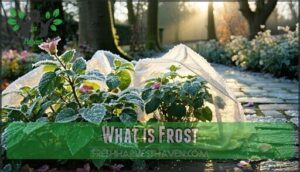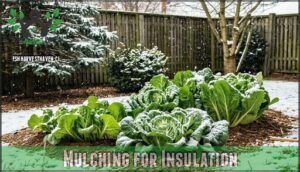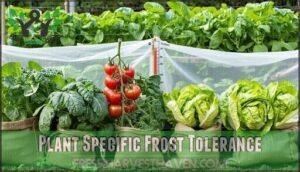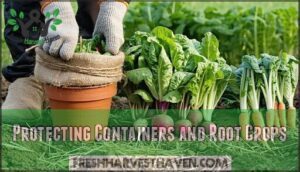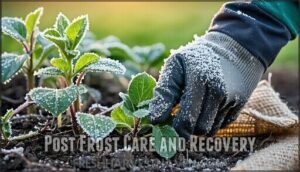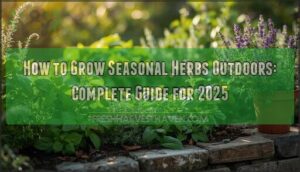This site is supported by our readers. We may earn a commission, at no cost to you, if you purchase through links.
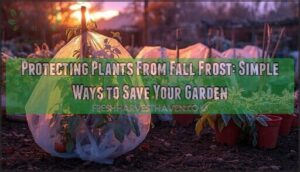 When temperatures drop toward 32°F, protecting plants from fall frost becomes critical to prevent overnight damage.
When temperatures drop toward 32°F, protecting plants from fall frost becomes critical to prevent overnight damage.
Frost forms when water vapor freezes directly onto plant surfaces, rupturing cell membranes as ice crystals expand inside cells.
Cover tender plants like tomatoes, peppers, and annuals with frost blankets, old sheets, or burlap before nightfall. Move containers indoors or wrap them for insulation.
Apply mulch around root crops and maintain moist soil to retain ground heat. Remove coverings by mid-morning to prevent overheating.
Light frost kills tender annuals at 32°F, while hard freezes below 28°F damage most plants through cellular destruction. Smart timing and proper materials make all the difference.
Table Of Contents
- Key Takeaways
- What is Frost
- Frost Temperatures and Damage
- Identifying Frost Sensitive Plants
- Protecting Plants From Frost
- Mulching for Insulation
- Advanced Protection Techniques
- Timing Frost Protection
- Plant Specific Frost Tolerance
- Protecting Containers and Root Crops
- Post Frost Care and Recovery
- Frequently Asked Questions (FAQs)
- At what temperature should you cover your plants from frost?
- What is the best thing to cover plants with to protect from frost?
- What is the best thing to cover plants from frost?
- Should I water my plants before I cover them for a freeze?
- What plants need to be covered at 40 degrees?
- How does frost impact newly seeded lawns?
- Can frost affect plants in partially shaded areas?
- What pests or diseases can emerge after frost?
- Are fall-blooming flowers impacted by light frosts?
- Does frost influence soil nutrients or pH levels?
- Conclusion
Key Takeaways
- Cover tender plants when temperatures drop to 32°F or below – Use breathable materials like old sheets, frost blankets, or burlap rather than plastic, and secure edges to the ground to prevent cold air from sneaking underneath.
- Water your plants before frost hits – Apply water in the late afternoon, since moist soil retains heat better than dry ground, creating a protective buffer around root systems that radiates warmth through cold nights.
- Remove coverings by mid-morning – Take off frost protection once temperatures rise to prevent overheating and moisture buildup that can damage plants or create conditions for disease.
- Focus protection on the most vulnerable plants first – Prioritize tender annuals, like tomatoes and peppers, that die at 32°F, while hardy vegetables, like kale and Brussels sprouts, can survive temperatures down to 18°F without protection.
What is Frost
When temperatures drop below 32°F (0°C) near the ground, water vapor in the air condenses and freezes directly onto plant surfaces, creating the thin layer of ice crystals we call frost.
Nature’s nightly ice artistry can destroy your garden in hours—protection is everything.
This freezing process damages plants by rupturing cell membranes when water inside plant cells expands as it turns to ice, leaving you with blackened, wilted foliage and dead flower buds.
Frost Formation Process
Frost forms when ground temperature drops below 32°F, causing water vapor in the air to freeze directly onto plant surfaces as ice crystals.
This process happens most readily during clear skies and low wind conditions, which allow heat to escape rapidly from the ground.
The freezing point transforms moisture into delicate ice crystals that coat leaves, stems, and other plant tissues overnight.
Types of Frost Damage
When temperatures drop, your garden faces several types of frost damage that can devastate plant tissues overnight.
Understanding these common frost symptoms helps you recognize when your plants need immediate attention.
Here are the main types of frost damage you’ll encounter:
- Cell Rupture – Ice crystals form inside plant cells, causing them to burst and die
- Blackened Leaves – Foliage turns dark and appears burned from freezing temperatures
- Softened Stems – Plant stems become mushy and collapse from internal ice damage
- Flower Bud Death – Buds freeze solid, preventing future blooms and fruit production
Wilted Foliage often appears first, signaling that plant damage has begun.
Effects on Plant Cells
When freezing temperatures hit your garden, the damage isn’t just surface-deep.
Ice formation inside plant cells creates a devastating chain reaction that can kill your precious plants overnight.
One cold night can turn a thriving garden into a graveyard of frozen dreams
Here’s what happens when frost attacks your plants at the cellular level:
- Water freezing – Water inside plant cells expands as it turns to ice crystals
- Membrane disruption – Ice crystals pierce and tear delicate cell walls
- Cell rupture – Expanded ice breaks cells apart from the inside out
- Plant death – Damaged plant tissues can’t transport water or nutrients
This cellular destruction explains why frost damage appears so quickly, turning healthy leaves black and causing stems to collapse within hours of freezing temperatures.
Frost Temperatures and Damage
Understanding frost temperatures helps you decide which plants need protection and when to take action.
Different plants have varying tolerance levels, with some surviving light frosts while others suffer damage at the first hint of freezing weather.
Temperature Ranges for Frost Damage
Understanding the numbers behind freezing temperatures helps you protect your garden effectively.
Light frost occurs at 32°F, while hard freezes at 28°F cause severe cellular damage.
Air temperature drops below these critical thresholds trigger ice crystal formation in plant tissues, with exposure duration determining frost severity.
- Light frost (32°F): Kills tender annuals like tomatoes and peppers within hours
- Moderate frost (28-30°F): Damages semi-hardy vegetables such as lettuce and spinach
- Hard freeze (below 28°F): Causes cellular damage in most plants through ice expansion
- Severe freeze (below 25°F): Destroys even cold-tolerant crops like kale and brussels sprouts
Plant Sensitivity to Frost
Your plants don’t all react the same way to chilly temperatures.
New growth and tender buds show greater vulnerability than mature leaves, while environmental stress from drought or poor nutrition intensifies frost-related risks.
Microclimate effects around your garden create temperature thresholds that vary by location, making plant sensitivity depend on specific growing conditions and acclimation strategies.
Hardy and Tender Plant Categories
Gardeners face a plant-protection puzzle: knowing which varieties can weather fall frost and which need shelter.
Plant hardiness and frost tolerance create clear tender classifications that guide your species selection through regional variations.
- Hardy plants like kale and Brussels sprouts survive temperatures down to 18°F
- Semi-hardy vegetables including carrots and beets tolerate light frost to 28°F
- Tender plants such as tomatoes and peppers require frost protection at 32°F
- Tropical species need immediate indoor relocation when frost threatens
To extend the harvest, consider zone-based planting schedules for ideal timing.
Identifying Frost Sensitive Plants
Understanding which plants need frost protection helps you prioritize your garden care when temperatures drop.
While some plants handle cold weather naturally, others require immediate attention to survive even light frost conditions.
Vegetables Requiring Protection
Your tender vegetable list includes tomatoes, peppers, beans, eggplants, and cucumbers—crops that can’t handle frost damage.
These frost-sensitive crops need protection timing before temperatures drop to 32°F.
Master covering techniques like fabric row covers for effective vegetable frost protection.
Know your hardiness zones to identify which tender vegetables require immediate attention when frost threatens your garden.
Annuals and Tropical Plants
Most tender annuals can’t handle temperatures below 32°F and need immediate plant frost protection.
Tropical plants like coleus, impatiens, and begonias suffer frost damage quickly.
Container relocation works best for tropical sensitivity issues, so move potted annuals indoors for indoor overwintering before the first fall frost protection warning.
Frost tenderizing affects these plants within minutes of exposure.
Perennials and Woody Shrubs
Perennial frost resilience varies substantially among species, with hardy varieties surviving temperatures down to -6°C while tender ones fail at -1°C.
Woody shrub hardiness depends on proper fall frost protection and winterizing shrubs before cold snaps arrive.
Key frost-sensitive perennials and shrubs needing protection:
- Dahlias and cannas (die at first frost)
- Boxwood (25% leaf browning after mild frost)
- Hydrangeas and roses (bud damage below -2°C)
- Young transplants (2x more susceptible than mature plants)
- Mediterranean/subtropical varieties (least frost-tolerant)
Use frost blankets plants, burlap plant protection around crowns, and proper pruning after frost for recovery.
Protecting Plants From Frost
When fall temperatures threaten to drop below freezing, you’ll need to act quickly to shield your vulnerable plants from frost damage.
The good news is that protecting your garden doesn’t require expensive equipment—simple materials like fabric covers, indoor relocation, and basic structures can save your plants from a killing frost.
Covering Plants With Fabric
One effective method involves using frost blankets or old sheets to create insulation value around vulnerable vegetation.
Woven fabric types like cotton sheets, burlap, or frost cloths work better than plastic because they breathe while trapping warm air.
To find the right product, consider frost blanket options.
When securing covers, anchor edges completely to the ground with rocks or stakes—cold air sneaks through gaps like water finds cracks.
Application timing matters: cover plants in early evening before temperatures drop and removing covers by mid-morning prevents overheating.
Bringing Plants Indoors
Moving potted plants inside offers the most reliable frost protection tips for container plants.
You’ll need to check indoor lighting requirements and adjust humidity levels accordingly. Start an acclimation period by gradually moving plants to shadier spots before bringing them fully indoors.
Fresh potting soil and proper pest control measures guarantee your indoor protection strategy succeeds throughout winter months.
Using Cold Frames and Hoop Tunnels
Cold frames and hoop tunnels provide year-round protection for your plants when bringing them indoors isn’t practical.
These structures create controlled microclimates that extend your growing season effectively.
Here’s how to maximize their effectiveness:
- Cold Frame Design – Build with angled glass or clear plastic tops to capture maximum sunlight and guarantee proper drainage
- Hoop Tunnel Materials – Use PVC pipes or metal hoops covered with row covers or clear plastic sheeting
- Ventilation Strategies – Install automatic vent openers or prop open covers when temperatures exceed 70°F
- Temperature Regulation – Add thermal mass like water jugs to moderate temperature swings and prevent overheating
These structures can be easily assembled using pre-fabricated options.
These vegetable frost protection methods offer reliable plant covers frost solutions.
Mulching for Insulation
Mulching acts as nature’s blanket, creating an insulating layer that protects plant roots and crowns from freezing temperatures.
You can use materials like straw, leaves, wood chips, or hay to shield tender plants and keep root vegetables safe in the ground through light frosts.
Materials for Mulching
Smart mulching begins with selecting the right materials for your garden’s unique needs.
Organic Mulches like straw, leaves, and grass clippings decompose naturally, adding nutrients while providing soil protection. Inorganic Options including black plastic and landscape fabric offer consistent soil warming without decomposition concerns.
| Material Type | Temperature Benefit | Best For |
|---|---|---|
| Straw mulch | +50% soil insulation | Root crops, vegetables |
| Black plastic | +5°F soil warming | Tender annuals, tomatoes |
| Leaves | 20-30% moisture retention | Perennials, shrubs |
| Grass clippings | +2-3°F root zone buffer | Shallow-rooted plants |
Application Depth matters—2-4 inches provides ideal erosion prevention and insulation.
Consider Sourcing Materials locally to reduce costs while supporting your soil’s organic matter content effectively. To further enrich the soil, consider adding organic matter before mulching.
Application and Removal Techniques
Apply mulch around plants in late evening before frost arrives.
Secure Covers shouldn’t be too thick – three to four inches works best.
Water plants lightly before adding your Material Choice of straw, leaves, or wood chips.
For proper Covering Timing, remove mulch during warm days to prevent rot and overheating.
Daytime Removal prevents moisture buildup that damages roots.
Benefits for Root Crops
Root crops benefit tremendously from mulch’s soil insulation properties.
Thick mulch layers create freeze prevention barriers around carrots, beets, and turnips, enabling extended harvest periods well into winter.
This nutrient retention system enhances growth while providing essential frost protection tips for protecting plants during harsh fall conditions.
Advanced Protection Techniques
When you’ve covered your plants with basic materials but need extra protection for valuable crops, advanced techniques can make the difference between survival and loss.
These specialized methods work best for tender plants like tomatoes or when temperatures drop well below freezing, which is a critical factor in determining the need for extra protection.
Fleece and Row Covers
Fleece weight and row cover types offer gardeners reliable frost protection with excellent breathability factors.
These floating row covers trap warm air while allowing moisture to escape, preventing condensation buildup.
Installation methods involve draping covers directly over plants or supporting them with hoops.
Light transmission remains adequate for plant growth while frost blankets plants effectively.
Consider various fleece options for superior protection.
Choose breathable plant covers over plastic frost covers for better results.
Walls-O-Water for Tomato Protection
Walls-O-Water systems create individual water-filled cylinders around tomato plants, forming mini-greenhouses that protect against frost down to 16°F.
The water absorbs daytime heat and releases it overnight, keeping plants up to 12°F warmer than outside temperatures.
Install during transplanting, fill weekly, and remove when plants outgrow the 18-inch height for maximum tomato growth impact, using the Walls-O-Water systems effectively.
Irrigation and Moist Soil
Watering before frost isn’t just good sense—it’s essential frost prevention. Moist soil holds heat better than dry ground, creating a protective buffer around your plants’ root systems.
Consistent watering maintains soil moisture that radiates warmth upward through cold nights, giving your garden the edge against freezing temperatures.
- Water plants thoroughly in late afternoon before expected frost, ensuring deep root hydration
- Keep soil consistently moist throughout fall, as wet ground retains heat longer than dry earth
- Focus irrigation on root zones rather than foliage to maximize heat retention benefits, which is a key part of frost prevention strategies.
Timing Frost Protection
Timing your frost protection correctly makes the difference between saving your garden and losing it to an unexpected freeze.
You’ll need to watch weather forecasts closely and act fast when temperatures threaten to drop below your plants’ tolerance levels.
Monitoring Weather Forecasts
Your weather forecast becomes your garden’s crystal ball when frost threatens. Check forecasts daily during fall, focusing on overnight lows and frost prediction accuracy. Pay attention to microclimate awareness—your yard may differ from regional forecasts by several degrees.
Understanding radiation frost formation can help you anticipate these localized events.
| Forecast Element | What to Monitor | Action Threshold |
|---|---|---|
| Overnight Low | Temperature predictions | 35°F or below |
| Frost Advisory | National Weather Service alerts | Any frost warning issued |
| Wind Speed | Calm conditions increase frost risk | Under 5 mph |
| Cloud Cover | Clear skies promote heat loss | Less than 25% cloud cover |
| Humidity Levels | Dry air enhances frost formation | Below 60% relative humidity |
Long-range outlooks help you prepare protection materials early. Alert systems on your phone provide timely warnings when temperature thresholds approach your area’s frost dates.
Removing Coverings and Insulation
Once you’ve monitored the forecast and protected your plants, timing the removal of frost protection methods becomes your next priority.
Remove coverings by mid-morning to prevent plant damage from trapped heat and moisture buildup.
- Overheating Prevention: Your plants can literally cook under covers during sunny days
- Condensation Risks: Trapped moisture creates perfect conditions for plant diseases
- Gradual Acclimation: Sudden temperature changes shock plants more than frost itself
Check coverings early morning for condensation.
Remove frost blankets plants systematically, storing solutions properly for reuse.
Balancing Protection With Plant Growth
Effective frost protection techniques require careful timing between covering plants and allowing essential sunlight exposure.
Remove coverings each morning to prevent overheating while ensuring proper airflow importance for healthy plant development.
Monitor plant health regularly, watching for signs that protection is hindering growth after protection periods.
Hardening seedlings gradually builds their cold tolerance, extending growing season naturally, and achieving a balance between frost damage prevention and necessary light and air circulation for ideal results.
Plant Specific Frost Tolerance
Understanding your plants’ frost tolerance helps you prioritize protection efforts and make smart choices about which crops to save first.
Different plants have varying cold thresholds, so knowing these limits lets you focus your time and resources on the most vulnerable species while letting hardier plants fend for themselves.
Knowing Plant Frost Tolerance
Understanding your plants’ frost tolerance helps you protect the right ones at the right time.
Hardy plants like kale survive temperatures down to 19°F, while frost-sensitive tomatoes suffer damage at 32°F.
Plant genetics determine baseline cold-hardy traits, but acclimation strategies and microclimate impact affect actual survival.
Regional variations across hardiness zones mean local conditions matter more than general guidelines.
Selecting Frost-Resistant Plants
When building your garden’s defense against frost, choose plants like kale and Brussels sprouts that thrive in cold temperatures.
Native varieties adapted to your Hardiness Zones offer better genetic resistance than tropical imports.
Select cold-hardy plants with proven frost tolerance for your microclimate.
Time plantings so cold-resistant plants mature before harsh weather hits.
Site Selection for Plant Placement
Strategic garden placement shields plants from frost’s harshest effects. Choose south-facing slopes for maximum sun exposure and natural warmth retention.
Avoid low-lying areas where cold air settles—elevation matters for frost protection. Plant tender varieties near buildings or windbreaks that create beneficial microclimates.
Well-draining soil prevents root damage from freeze-thaw cycles.
Protecting Containers and Root Crops
Container plants need extra protection because their roots are more exposed to cold than in-ground plants.
You can move small containers to sheltered areas like garages or wrap larger pots with insulating materials to prevent root damage from freezing temperatures.
Container Plant Protection
Container relocation offers the simplest protection method for potted plants during frost threats. Move small containers indoors to garages, sheds, or basements before temperatures drop.
For larger pots, try container grouping against warm walls or structures to create beneficial microclimates. Insulating containers with bubble wrap, burlap, or blankets prevents root freezing.
Watering strategies include thorough hydration before cold snaps, as moist soil retains heat better than dry conditions.
Root Crop Protection Methods
When frost threatens your root crops, quick action can save your harvest.
Soil insulation becomes your first line of defense against freezing temperatures that damage underground vegetables.
- Apply 4-6 inches of straw mulch around root crops to maintain soil temperatures and prevent freeze damage
- Use hilling techniques by mounding soil around carrot and parsnip tops to protect crowns from frost exposure
- Time your harvest strategically by monitoring forecasts and pulling sensitive varieties before hard freezes hit
Special Considerations for Container Plants
While root crops benefit from in-ground insulation, potted plants face unique challenges during fall frost.
Container material affects temperature retention – ceramic and stone pots insulate better than plastic.
Pot size matters since larger containers retain heat longer than small ones.
Drainage importance can’t be overlooked, as waterlogged containers freeze faster.
Mobility options let you move containers to protected areas.
Microclimate effects around elevated containers increase cold exposure compared to ground-level plants, due to the impact of elevated containers and cold exposure on the plant’s overall health, and the need for protected areas.
Post Frost Care and Recovery
Even the best frost protection can’t prevent all damage when temperatures drop unexpectedly low.
After a frost event, you’ll need to assess what survived and help your plants recover through proper care and cleanup.
Assessing Frost Damage
After protecting your containers and root crops, you’ll need to examine your plants carefully the morning after frost hits.
Look for visual symptoms like blackened leaf edges, wilted foliage, and softened stems to determine the extent of damage.
Check frost damage plants thoroughly, as some areas may show frost damage symptoms while others remain healthy, affecting your salvage options and plant recovery strategies moving forward.
Recovering Damaged Plants
When frost damage strikes, patience becomes your greatest ally in nursing plants back to health. Proper frost recovery requires careful timing and strategic care.
- Delay pruning frostbite until spring growth appears—damaged tissue boundaries take weeks to show
- Water consistently but avoid overwatering, which causes root rot during plant stress
- Wait on fertilizing recovery until freeze danger passes to prevent tender growth
- Monitor for pest management issues, treating fungal infections on wounded areas
- Maintain soil health through deep watering rather than frequent shallow applications
Cold weather helps in reducing pest populations by killing overwintering pests.
Preventing Future Frost Damage
Learning from frost damage helps you build stronger defenses for next season.
Focus on plant selection by choosing cold-hardy varieties suited to your hardiness zone.
Improve microclimate design through strategic site preparation, placing tender plants near south-facing walls or sheltered areas.
Practice hardening seedlings gradually before transplanting.
Understanding a tree’s critical temperature point can help prevent damage.
These fall frost tips and frost protection techniques create lasting frost damage prevention systems for your garden’s future success.
Frequently Asked Questions (FAQs)
At what temperature should you cover your plants from frost?
Like a guardian watching over sleeping children, you’ll want to tuck your plants in when temperatures drop to 32°F or below.
Securing covers completely to prevent cold air from sneaking underneath.
What is the best thing to cover plants with to protect from frost?
Use breathable fabric covers like old bed sheets, blankets, or frost cloths rather than plastic.
These materials trap warm air while allowing moisture to escape, preventing condensation that could freeze and damage your plants further, which is made possible by using breathable fabric.
What is the best thing to cover plants from frost?
Ironically, the simplest materials work best: old bed sheets, blankets, or burlap trap warm air while letting plants breathe. Avoid plastic—it’ll freeze your plants faster than leaving them uncovered.
Should I water my plants before I cover them for a freeze?
Yes, you should water your plants lightly in the late afternoon before covering them. Moist soil holds more heat than dry soil, helping protect roots from freezing temperatures overnight.
What plants need to be covered at 40 degrees?
At 40°F, most plants don’t need covering, but tender tropicals like hibiscus, citrus trees, and sensitive houseplants outdoors might benefit from protection before temperatures drop further overnight.
How does frost impact newly seeded lawns?
Frost can severely damage newly seeded lawns by freezing grass seedlings and preventing germination. Young grass lacks established root systems, making it vulnerable to frost damage and potential die-off.
Can frost affect plants in partially shaded areas?
Partially shaded areas don’t offer complete protection from frost. Cold air still settles there, and temperatures can drop below freezing, threatening tender plants just like sunny spots.
What pests or diseases can emerge after frost?
Studies show 40% of frost-damaged plants develop secondary infections.
After frost weakens your plant’s defenses, you’ll likely see fungal diseases like botrytis, bacterial soft rot, and powdery mildew emerge, plus increased aphid and spider mite activity targeting compromised tissues.
Are fall-blooming flowers impacted by light frosts?
Fall-blooming flowers face different vulnerabilities during light frosts.
Tender annuals like impatiens and begonias’ll suffer immediate damage, while hardy mums and asters can typically handle brief temperature drops to 32°F without major harm.
The main concern for these flowers is the potential for immediate damage from frost.
Does frost influence soil nutrients or pH levels?
No, frost doesn’t directly change soil nutrients or pH levels.
However, repeated freeze-thaw cycles can break down organic matter faster, potentially releasing nutrients.
You’ll see the biggest impact on plant uptake, not soil chemistry itself, with a significant effect on how plants absorb nutrients.
Conclusion
Surprisingly, protecting plants from fall frost doesn’t require expensive equipment or complex techniques.
You’ve learned that simple materials like old sheets, mulch, and proper timing can save your garden from freezing temperatures.
While frost may seem like an inevitable threat, you now have practical strategies for protecting plants from fall frost.
Monitor weather forecasts, cover tender plants before nightfall, and remove coverings by mid-morning to keep your garden thriving through unpredictable fall weather.
Your proactive approach will keep your garden thriving through unpredictable fall weather.

